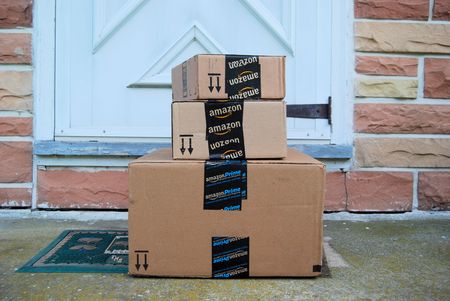在搞死無(wú)數(shù)實(shí)體店后,,亞馬遜自己開(kāi)起了實(shí)體店

|
上周,亞馬遜(Amazon)在紐約市開(kāi)設(shè)了第七家實(shí)體店,,此舉看起來(lái)相當(dāng)違反直覺(jué),。為什么這家將許多實(shí)體書店推向死亡的公司會(huì)去自己開(kāi)設(shè)實(shí)體店,?然而,戰(zhàn)略角度上看,,實(shí)體店不僅不是公司在圖書零售的后退,,反而讓他們?cè)跇?gòu)建獨(dú)特的跨領(lǐng)域、多渠道品牌上前進(jìn)了一大步,。實(shí)體店可能會(huì)給亞馬遜帶來(lái)以下幾條好處: 內(nèi)容探索 亞馬遜的網(wǎng)上書店可以讓消費(fèi)者輕松找到他們需要的書,。但是巨大的清單也有代價(jià):對(duì)于那些不確定自己想要什么的消費(fèi)者而言,選擇實(shí)在太多了,。亞馬遜網(wǎng)站是引領(lǐng)“一鍵”網(wǎng)上購(gòu)物的先鋒,,它對(duì)于那些想要購(gòu)物時(shí)節(jié)約時(shí)間的消費(fèi)者而言是個(gè)很棒的選擇,而實(shí)體店則更適合想要消磨時(shí)間找找新書的人,。為此,,亞馬遜列出了消費(fèi)者評(píng)分最高的作品排名,甚至還有Kindle數(shù)據(jù)給出的閱讀速度排名,。 內(nèi)容推銷 除了推銷其他出版商的作品之外,,實(shí)體店也讓亞馬遜有機(jī)會(huì)推銷自己的內(nèi)容。沒(méi)錯(cuò),,亞馬遜不只是經(jīng)銷商,,本身也是多產(chǎn)的內(nèi)容提供商。亞馬遜工作室推出了一系列大作,,其中還包括廣受好評(píng),、榮膺今年奧斯卡獎(jiǎng)的原創(chuàng)電影《海邊的曼徹斯特》(Manchester by the Sea)。亞馬遜有著龐大的消費(fèi)者基礎(chǔ),,而且不僅對(duì)他們的喜好了如指掌,,還能輕易聯(lián)系到他們。公司正摩拳擦掌,,志在以經(jīng)銷商和內(nèi)容開(kāi)發(fā)商的身份成為娛樂(lè)界的巨頭之一,。這樣的情況下,實(shí)體零售店可以作為亞馬遜自身數(shù)字內(nèi)容的推銷地點(diǎn),,無(wú)論那是圖書,、音樂(lè)、視頻還是電影,。 設(shè)備展示 亞馬遜的實(shí)體店正在成為展示廳,,人們可以體驗(yàn)到公司最新的產(chǎn)品,包括Kindle電子閱讀器,、Fire平板電腦和Echo個(gè)人助手,。即使亞馬遜想要在實(shí)體店提高圖書銷量,憑借這些店面所在的地段,,只需要展示出產(chǎn)品和服務(wù),,讓消費(fèi)者體驗(yàn)到網(wǎng)購(gòu)不可能獲得的產(chǎn)品觸覺(jué)體驗(yàn),,都能為亞馬遜創(chuàng)造價(jià)值。百思買(Best Buy)就采用了這種戰(zhàn)略,,他們最近與微軟(Microsofe),、三星(Samsung)和索尼(Sony)等公司合作來(lái)推銷產(chǎn)品。亞馬遜不需要與其他公司合作,,可以直接推銷自己的電子產(chǎn)品,,這讓開(kāi)實(shí)體店變得很劃算。 推動(dòng)Prime服務(wù) 亞馬遜還將實(shí)體店作為推銷每年99美元的Prime會(huì)員的新途徑之一,。這里的吸引力在于,,零售店的消費(fèi)者成為Prime會(huì)員,就能避免支付店內(nèi)的標(biāo)價(jià),,那可比亞馬遜網(wǎng)店的價(jià)格高得多,。把消費(fèi)者變成Prime會(huì)員,是亞馬遜商業(yè)模式中重要的一部分,,因?yàn)檫@不僅可以提高顧客忠誠(chéng)度——就像好市多(Costco)等其他擁有會(huì)員制的零售商一樣——還可以很大程度地帶來(lái)盈利,。亞馬遜還在實(shí)體店和網(wǎng)店推銷著自己的信用卡,這有助于進(jìn)一步提高顧客忠誠(chéng)度,。 品牌建設(shè) 除了功能上的利好,,實(shí)體店還可能讓亞馬遜的品牌具象化,增加它在消費(fèi)者中的存在感,,從而豐富亞馬遜的品牌形象,。這一方面,亞馬遜的零售戰(zhàn)略模仿了耐克(Nike),、迪斯尼(Disney),、蘋果(Apple)和微軟,他們都用實(shí)體店展示自己的品牌,,借此增強(qiáng)顧客的忠誠(chéng)度,。亞馬遜在紐約哥倫布圓環(huán)廣場(chǎng)(Columbus Circle)的新店,是在銷售圖書之外一次品牌建設(shè)的絕妙之舉,。 在其他書店舉步維艱之際,亞馬遜的實(shí)體店能否取得成功,?只有時(shí)間能告訴我們答案,。但是亞馬遜是一家以消費(fèi)者為中心的技術(shù)公司,他們知道如何使用數(shù)據(jù)來(lái)確定,、跟蹤和預(yù)測(cè)消費(fèi)者的偏好,。通過(guò)在書店內(nèi)建立自己的展示區(qū),亞馬遜凸顯了他們通過(guò)多種渠道推銷產(chǎn)品的能力,,同時(shí)還能利用可擴(kuò)展性和高效益物流帶來(lái)的優(yōu)勢(shì),。這些優(yōu)勢(shì)沒(méi)有辦法單靠賣書就得到充分利用,,而是要通過(guò)廣泛的產(chǎn)品組合和服務(wù)來(lái)發(fā)揚(yáng)光大。因此,,亞馬遜實(shí)體書店的成功,,是利用其生態(tài)系統(tǒng)下各種產(chǎn)品的協(xié)同效應(yīng)而實(shí)現(xiàn)的。公司若要讓實(shí)體書店的銷售模式成功回歸,,這些協(xié)同效應(yīng),,配合忠實(shí)的消費(fèi)者群體與合理的管理手段,將會(huì)起到巨大的助力,。(財(cái)富中文網(wǎng)) 作者亞歷山大?切內(nèi)夫是美國(guó)西北大學(xué)凱洛格商學(xué)院的教授,。 譯者:嚴(yán)匡正 |
Amazon’s seventh physical store opening—the latest in New York City last week—might seem rather counterintuitive. Why would a company that is responsible for the demise of many bricks-and-mortar retail stores bother to open its own physical stores? Yet, from a strategic standpoint, brick-and-mortar stores are not a slip backward into book retailing, but rather a step forward toward establishing a unique, cross-category, omni-channel approach. There are several ways in which physical stores might benefit Amazon: Content discovery Amazon’s online bookstore is a place where customers can easily find the book they are looking for. But its huge inventory comes at a cost: There is simply too much choice available for consumers who are unsure about what they want to read. Amazon.com—the pioneer of “one-click” online purchasing—is a great option for customers who like to save time when shopping, but its brick-and-mortar stores work better for customers who want to spend time discovering new reads. To this end, Amazon makes it easy by curating lists of books by consumer ratings, and even the speed of reading the content, as measured by Kindle data. Content promotion In addition to promoting other publisher titles, physical stores provide Amazon (amzn, -0.21%) with an opportunity to promote its own content. Indeed, Amazon is not only a distributor, but also a prolific content creator. Among the major hits from Amazon’s studios is the critically acclaimed original movie, Manchester by the Sea, which won an Oscar this year. Given that Amazon has a large customer base whose preferences it knows intimately and whom it can easily reach, Amazon is poised to become a major force in the entertainment industry, both as a distributor and as a content developer. In this context, physical retail locations can serve as a viable venue for promoting Amazon’s own digital content, be it books, music, videos, or movies. Device showcase Amazon’s physical stores are becoming showrooms where people can experience its latest gadgets, including Kindle e-readers, Fire tablets, and the Echo personal assistant. Even if Amazon were to break even on book sales in its physical stores, these brick-and-mortar locations could create value for Amazon merely by showcasing its products and services and giving consumers a tactile experience of products in a way that isn’t possible online. Best Buy has embraced this strategy, recently partnering with companies such as Microsoft, Samsung, and Sony (sne, +0.38%) to promote their products. In Amazon’s case, this approach does not need an external partner—it could make its brick-and-mortar stores worthwhile by promoting its own electronics. Boost for Amazon Prime With physical stores, Amazon is also finding new ways to promote its $99-a-year Prime membership. The hook is that retail store shoppers must be Prime members to avoid paying the list price, which could be much higher than Amazon’s online price. Transitioning Amazon customers into Prime members is an important aspect of Amazon’s business model because it not only increases customer loyalty but—as in the case with the other membership-based retailers such as Costco—makes a significant contribution to its bottom line. Amazon is also promoting its branded credit card in its stores and online, which can help garner even greater consumer loyalty. Brand-building In addition to their functional benefits, physical stores have the potential to enrich Amazon’s brand image by adding a tangible dimension to the brand and increasing its prominence in consumer minds. In this context, Amazon’s retail strategy mirrors that of companies like Nike(nke, +0.13%), Disney(dis, -0.37%), Apple(aapl, -0.51%), and Microsoft (msft, -0.81%) that have used their physical locations to increase customer loyalty by showcasing their brands. Amazon’s new store at Columbus Circle in New York embodies an astute brand-building move that goes well beyond selling books. Will Amazon’s brick-and-mortar bookstores succeed where other booksellers are struggling? Only time will tell. But Amazon is a customer-centric technology company that knows how to use data to identify, track, and anticipate consumer preferences. By creating its own showrooms in its bookstores, Amazon has heightened its ability to promote its offerings across multiple categories while still capturing the benefits of scalability and cost-efficient logistics. These benefits cannot be optimized by bookselling alone, but they can be captured across a broad portfolio of products and services. Thus, the success of Amazon's physical bookstores hinges on utilizing the synergies across the different offerings in its ecosystem. These synergies, coupled with a loyal customer base and sound management, should go a long way to help Amazon succeed in bringing back the brick-and-mortar bookseller business model. Alexander Chernev is a professor at Kellogg School of Management at Northwestern University. |













